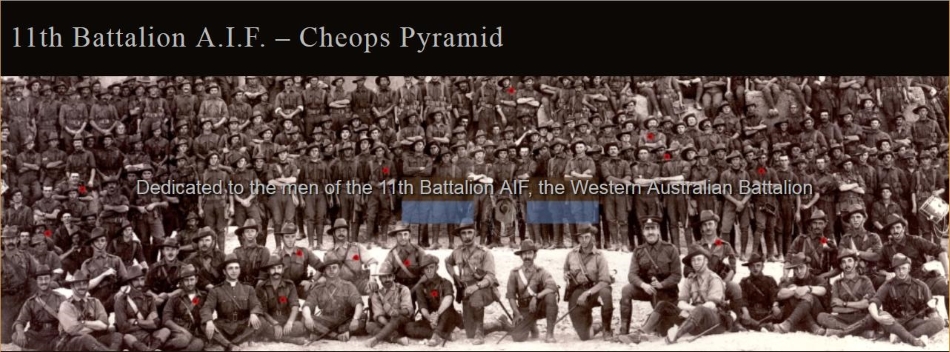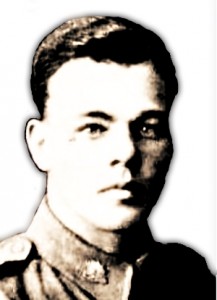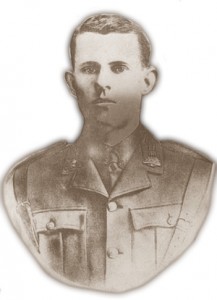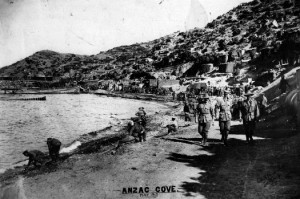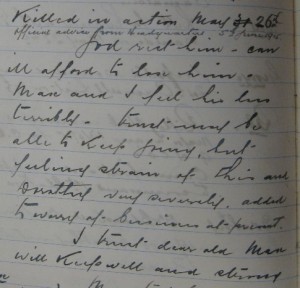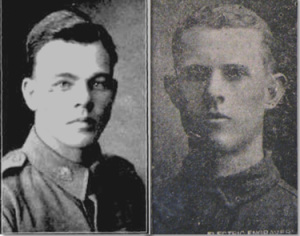 George HENDERSON SMITH – KIA &
George HENDERSON SMITH – KIA &  Christopher FORREST – KIA, Cheops ID#'s unknown
Christopher FORREST – KIA, Cheops ID#'s unknown
"This war is a sorry thing for Australia..."
George Holt Henderson Smith (above left) and Chris Forrest (above right) enlisted in the AIF at Blackboy Hill, Western Australia in the August of 1914. Chris was twenty, George nineteen.
Both were South Australian born and having had several years' experience in the 86th Infantry were assigned to the machine gun section of the 11th battalion.
They were tall lads, one dark, one fair with very different backgrounds. George was the son of a businessman, the eldest boy in a family of five and had been educated at the exclusive Sydney Grammar School. Chris in contrast, was the youngest of the eight children of an orchardist and had attended Claremont State School.
After departing Fremantle on the Ascanius in November 1914 for destinations unknown, Chris and George found themselves in Egypt, in the shadows of the pyramids at Mena Camp.
At the end of February, having grown tired of training and life in the desert, they rejoiced when orders were received to strike camp. At the Egyptian port of Alexandria, the 11th Battalion boarded the transport HMT Suffolk which headed for Mudros Harbour on the Greek Island of Lemnos. After enduring a further seven weeks on Lemnos, ‘amist a city of floating iron and steel’ these two young lads learned that as members of the 3rd Brigade, they were to be part of the covering force for the landing at the Dardanelles. George penned a few poignant words to his father on a postcard
Lemnos, Saturday, 24th April. My dear Father, After our long stay at this island we are at last about to land on the Gallipoli Peninsula and commence operations in real earnest. We shall be hard at it before tomorrow morning and of course we all feel the situation pretty keenly. I am quite well and fit to do my little bit. I hope this card reaches you safely and in the meantime Goodbye. With love to all at home. Laddie
A fortnight later, Chris had left the Peninsula and was back in Egypt, writing to his mother and detailing what had happened at the landing on Sunday 25th April as well as the circumstances of his wounding.
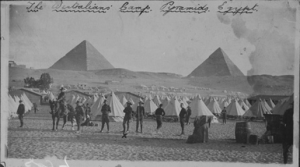 The Westralians' Camp near Pyramids (Mena Camp)
The Westralians' Camp near Pyramids (Mena Camp)
Image Courtesy Edwina Shooter
San Stefano Hospital Alexandria 8 May 1915
Dear Mater
I expect by the time this reaches you, full details of the fighting which took place will have been published in the papers so I will not worry you with the details. Sufficient to say that our Battalion was one of the first to land on Sunday 25th April. Before we landed the Turks started to fire on us so you can judge it was no easy game but the chaps took it like heroes although we had to hop out into the water up to our chests and wade ashore.
Well we got going and drove the Turks back about 2 miles from the shore then we came across some trenches of theirs which we occupied , they then commenced to attack us but we managed to hold on all Sunday until we managed to get more reinforcements and ammunition.All the time the Turks kept firing at us both with shrapnel and rifles as hard as they could shoot, but our crowd hung to it like Britons. Sunday night was as bad, not a wink of sleep, expecting to be attacked every moment, but as luck would have it, the Turks would not tackle us with the bayonet.
Monday morning was just as bad and at about 9am they got me in the shoulder with a bullet which finished me as far as fighting was concerned. (George) Henderson Smith was with me at the time and with a good deal of risk to himself from bullets, he got me out from the firing line down to the ambulance people who bandaged me up and a few hours later, sent me down to the beach and then aboard the boats which brought us to the hospital here. My wound is not at all serious and is now in fact almost well except for the stiffness in my right arm which makes it difficult to write as you see. I sent you a cable as soon as I was able which I hope you received safely.
Do not be anxious about me as they look after us well here and we get first class medical attention and everybody is getting well quickly. I was very lucky to get off as lightly as I did as you will see from the papers that we had a fearful lot of killed and wounded, the only satisfaction is we did what was required of us and from what I can hear we did it well.
Now I must close as my arm is getting tired. Love to you all especially you and Dad because I know how you will be worrying. Address all letters for the present to above address. I have not seen or heard anything of Austen because our Artillery did not land with us and so I do not know how he got on.
Remember me to everybody. Will write again soon.
Chris
Meanwhile George found time to pen his own account of the landing at Gallipoli and what had transpired since.
Anzac Cove, Gallipoli Peninsula, Friday, May 14, 1915
You will be pleased to receive a letter from me at last giving you a few more details other than the bare fact that I am quite well, which is the only news conveyed by the service postcards I have been sending you. To commence from the time we left Egypt, we were at the Isle of Lemnos 51 days, leaving there on the 25th ult. Our destination after leaving was to a place called Gaba Tepe, on the N.W. Side of Gallipoli Peninsula, where we were to make a landing.
The 3rd Brigade being the advance guard or covering party of the division landed from warships and torpedo boats between three and four a.m. Sunday, 25th ult. Strict orders had been issued that there was to be no firing until daylight, all work to be done with bayonets. The actual landing was done by means of small boats which were towed ashore several at a time by the piquet boats of the warships. When close to the shore, the piquet boats cast off, the short distance then intervening being rowed by our men.
When near the shore the enemy opened a heavy fire of shrapnel, also a heavy rifle and machine gun fire. Lots of men were hit whilst in the boats, and our feelings under the circumstances may be better imagined than described. Our men jumped out up to their waists in the sea, and as soon as dry land was reached, off came packs and fixing bayonets, charged up the steep hill from the shore. This ridge and two more were taken before we stopped, having gained about a mile or more from the beach. Meanwhile the rest of the division landed as fast as possible and hurried up to reinforce us.
The gun section landed without any casualties and after recovering its wind on the beach, pushed on to the firing line. By this time it was daylight and we could see where we were going, and by the Lord I do not want such another trip. It was up hill and down dale slipping down the steep slopes on the seat of one's trousers, and toiling up steeper slopes. I was the first of the section to reach the firing line, and I was just about done up with the steep climbing. All the others were a little worse when they arrived with their loads.
We got the guns going as soon as possible, but the position was pretty exposed and caused us to change about a little till we obtained good cover. Towards dusk, my gun jammed owing to the copper round the barrel melting with the heat of firing and soldered it to the muzzle attachment. We got this cleared away, and whilst getting back into position again, the sergeant was shot through the neck, putting him out of action for some days. Shortly afterwards another of the section was wounded through the chest. These were our first casualties. During the night we managed to get the gun forward to a better place which we improved by digging a good gun pit before morning. Taken all round, it was a very strenuous day under heavy fire all the time.
The next four days were tough, but we did tip top work. The gun was firing continually, simply eating up ammunition and water as fast as it could be brought up. When water was slow in coming up, clouds of steam from the boiling water gave our position away, and we then came in for a hot fire. Our no.2 gun was put out of action on the second day and another section took its tripod, as it was useless to us, and they badly need one, theirs having been shot to pieces by a shell. It was not till next morning that the gun was repaired, just in time to replace mine which had had the feed block shot away. This would not stop us in the ordinary course of events, but we had lost our spare parts box first day and it meant a trip to the beach to pick up what we could find and spares we could borrow before we could get going again. Each time something went wrong, it meant I had to sprint over the crest of the ridge with the gun to the corporal and take back the other one. When the beggars saw the gun, they let drive a hail of bullets, but I was never hit.
On Thursday (29th) evening, we were relieved and had a couple of days' good rest on the beach. Our casualties during the first five days were six men wounded amongst them being Forrest, who received a bullet in his shoulder. Of these men, the sergeant, I am glad to say, is back with us again now, his wound was only a slight one. Harvey Rae lost his left arm, whilst Harold George, George Demel, and Ron Rowley of the 16th Battalion, were all killed. Mr. Carse, too, was seriously wounded, and has since died.
A good many more friends were killed, as you will see from the official casualty lists. Taken all round, the first week was very strenuous and our battalions became all mixed up together, and the fight during that time ebbed and flowed. To make things worse, German officers disguised in our uniforms got amongst us and kept sending orders to "Cease Fire!" etc., along our lines, which at first we took notice of, but soon learnt the state of affairs and used our own judgment. These men got short shrift when caught, and the game is impossible now.
Things now are well in order, and being dug in, we're here to stay. . You will be pleased to hear I was recommended for a commission, and am now a second lieutenant, my appointment dating from April 29. Major Drake Brockman is now my company commander and he sends his very best respects to you.
On 26th May, that same Major Drake Brockman was seated in the dugout he shared with George, writing a letter home.
….the enemy is a pretty brave sort of a fool and seems to delight in being slaughtered……. armistice yesterday .. Everything seemed depressed it was so terribly quiet while the burial parties were out—it was quite a relief when it was all over and the rattle of fire-arms of various types commenced once more. We’ve gone back to the primitive and live in holes in the earth. I share a dugout with the only two officers I have left, MacFarlane and (Henderson) Smith the last named recently promoted from the ranks. The others ... are all wounded and in hospital somewhere…..
Out of the men I landed with I have comparatively few left.
Whilst Drake Brockman continued writing his letter, instead of sending somebody else to do it, George climbed out of the dugout and over the parapet to fix a loopline from the outside. As he was climbing back into the trench, a sniper fixed him in his sights and a bullet zinged through the air. Within minutes George lay dying in the bottom of the trench having been shot through the head.
He had the makings of a brilliant officer and was cool almost to a fault… he was a fine boy, one of the quiet masterful sort. I am fed up with trench warfare and it would be much more pleasant to get out and have a go in the open. Somehow when men get outed in a general scrap one does not seem to mind but when they get picked off one by one and always through the head through the loopholes it is the dead limit and most depressing.
The news of George’s death reached his father on 5th June and he wrote in his diary…..
Killed in action May 26th. God rest him- can ill afford to lose him. Max and I feel his loss terribly. Trust may be able to keep going but feeling the strain of this and Dorothy very severely, added to worry of business at present . I trust dear old Max will keep well and strong.
[NOTE: Max was George’s younger brother and Dorothy, his older sister who died in November 1920. Another sister Barbara, died in February 1917]
On 11th June, still in Alexandria Egypt but now convalescing at the Mustapha Pasha Camp, Chris again wrote home.
………….. I suppose you have heard from the papers by now that Henderson Smith was killed after I left. He had been promoted to a Lieutenant and was killed a few days after. As he was one of the best pals I had, you can imagine how I felt when I heard. It was partly due to him that I got safely back to the firing line when I was wounded. As soon as he heard that I was wounded he ran out and got me and bound me up and though the snipers were trying to pick him off, he never left me till I was safely in the hands of the Red Cross, and all through he showed himself as a brave and white man if ever there was one.Burial service for Lt. George Henderson-Smith.
Image courtesy Ian Gill, Fremantle to France p31
Lieut. Carse has also gone I believe, Demel and Harold George from Claremont were all pals together if you remember so I am about the only one left of the old crowd, "This war is a sorry thing for Australia" and God knows how many of us will ever see home again as I believe some Battalions are almost wiped out and still the thing goes on. There is only one consolation, we have made such a name for ourselves that they won’t forget in a hurry……
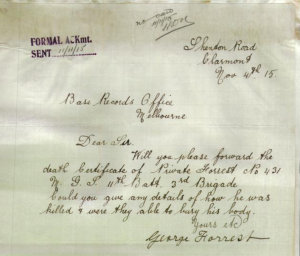 At the end of July, three months after his wounding at the Gallipoli landing, Chris returned to the Peninsula and rejoined his battalion and was almost immediately involved in the fierce fighting at Leane’s Trench.
At the end of July, three months after his wounding at the Gallipoli landing, Chris returned to the Peninsula and rejoined his battalion and was almost immediately involved in the fierce fighting at Leane’s Trench.
A mere week after his return to the fray which coincidentally was also a week after his 21st birthday, Chris was killed in action.
Robert Henderson Smith received many letters of condolence from fellow officers and others and a photo of his son’s burial was published in the Daily Mail in 1915.
George Forrest however, was obliged to write to the military authorities respectfully asking for information about the manner of his son’s death and burial.
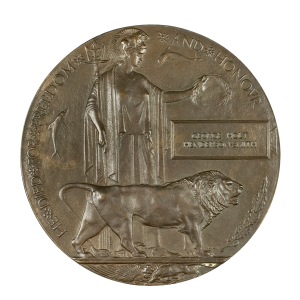 2nd Lt. George Holt Henderson-Smith, Next of Kin Plaque, AWM rel-04530
2nd Lt. George Holt Henderson-Smith, Next of Kin Plaque, AWM rel-04530
Chris and George. For King and country
We will remember them
Researched and written by Julie Martin
Sources
Hurst, James - Game to the Last: the 11th Australian Infantry Battalion at Gallipoli. 2nd ed, 2011.
Henderson-Smith, Robert. Private Archives.
Acc 5781A, items 1,8 Battye Library, State Library of WA
Australian War Memorial (www.awm.gov.au)
National Archives of Australia (www.naa.gov.au)
National Library of Australia, Trove (http://trove.nla.gov.au)
